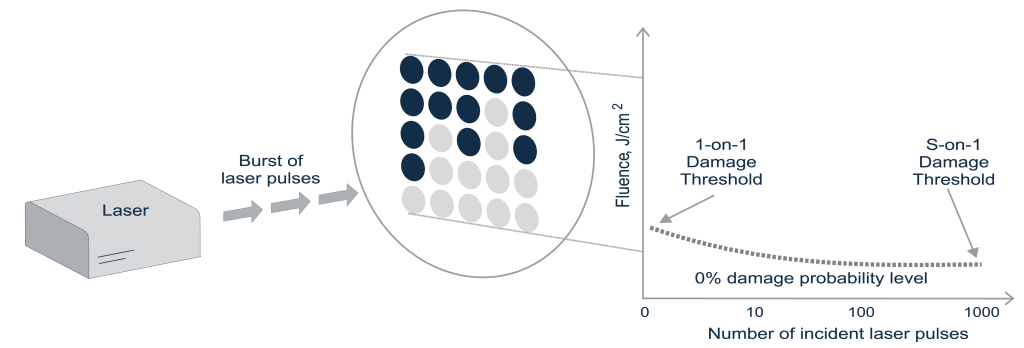
ISO S-on-1 LIDT test (21254-1,2)
S-on-1 test explained:
Use this test for:
- Specification of “typical” LIDT numbers of your optics;
- Characterization of “fatigue-driven” laser damage to see if optics performance is changing in time;
- Investigation of possible failure modes (damage mechanisms) that might develop over time;
- Examination of the optic’s lifetime (in combination with prolonged exposure and data extrapolation);
Test description
The entrance surface of the optical element is divided into a matrix of test sites. Each test site is then exposed to a burst of laser pulses with fixed laser peak fluence. Distinct fluences levels are used for individual test sites. During irradiation sample is monitored for damage: if the damage is detected irradiation is stopped and the dose required to trigger damage is recorded. Otherwise, if samples survive a maximum number of S laser pulses irradiation is stopped for that test site. After exposure, the status of all test sites is also inspected with offline microscopy. Collected damage statistics are then used to calculate LIDT dependence versus the number of applied laser pulses (exposure dose).
Known limitations and risks:
- Not possible for very limited surface samples (fibers, testing areas <1mm, etc.: use R-on-1 instead);
- Not repeatable/Overestimates LIDT for samples with a very large aperture (extremely low defect density: use raster scan instead);
- Testing at very high repetition rates might cause annealing or contaminations of neighboring test sites. Thus, LIDT can be overestimated or underestimated;
- Testing with less than 1000 pulses is only suited to characterize defect-driven damage mode (long-term degradation effects require a much higher irradiation dose.

Most popular test parameters for this test
| Wavelength | Pulse duration(1) | Repetition rate | Pulses per irradiation level | Interested? |
| 2100 nm | 4 ns | 100 Hz | 1 000 | ORDER |
| 1500 nm | 4 ns | 100 Hz | 1 000 | ORDER |
| 1064 nm | 10 ns | 100 Hz | 1 000 | ORDER |
| 1064 nm | 10 ns | 10 Hz | 200 | ORDER |
| 532 nm | 5 ns | 100 Hz | 1 000 | ORDER |
| 355 nm | 5 ns | 100 Hz | 1 000 | ORDER |
| 1030 nm | 10 ps | 1 kHz | 10 000 | ORDER |
| 1030 nm | 180 fs | 50 kHz | 1 000 000 | ORDER |
| 1030 nm | 180 fs | 100 kHz | 1 000 000 | ORDER |
| 515 nm | 180 fs | 50 kHz | 1 000 000 | ORDER |
| 343 nm | 180 fs | 50 kHz | 1 000 000 | ORDER |
| 800 nm | 50 fs | 1 kHz | 10 000 | ORDER |
| Custom | Check all availability or configure your own at my.lidaris.com | |||
(1) effective pulse duration measured at Full Width Half Maximum
Testing
conditions
Related tests
Show all-
"Classical"
Lifetime TestThis test is available at ps, fs pulse duration and @kHz repetition rates: allows to investigate LIDT, ageing and lifetimeread more -
Raster scan
LIDT testIt characterizes the worst-case scenario when it comes to large optics and defect-driven damageread more -
 ISO LIDT Certification Test (21254-1,3)This technique is designed to separate good and bad optics when end-use irradiation conditions are knownread more
ISO LIDT Certification Test (21254-1,3)This technique is designed to separate good and bad optics when end-use irradiation conditions are knownread more -
R-on-1
LIDT testTesting protocol, which provides preliminary information about the LIDT of the surface-limited samplesread more -
ISO 1-on-1
LIDT test (21254-1,2)Single-shot technique for determination of “intrinsic” laser-induced damage threshold of coatings.read more

Test bundles and packages
-
Find out more ›
Optics Characterization Bundle for CW regime at 1070 nm
The testing package consists of multiple tests, which are carefully selected to address optics characterization issues at the CW regime. -
Find out more ›
Lifetime + Certification Bundle for Industrial Grade fs-ps Laser Optics
The package consists of several tests carefully selected to address optics certification for critical applications.
more tools
and useful information
-
Find out more ›
Testing conditions
Check out all available laser damage testing conditions (wavelengths, pulse regimes, environments, and more). -
Find out more ›
Laser Damage infobase
Check out a useful glossary of terms and simple explanations related to the main topics of laser damage terminology. -
Find out more ›
Online Fluence calculator
Check out a calculator equipped with laser-related calculus that is frequently required in practice: such as laser fluence. -
Find out more ›
Downloads and docs
Here you can download all information about laser damage testing available at Lidaris. -
Find out more ›
New client guide
Here you will find usefull guidlines and suggestions for everyone, who is new the laser damage field. -
Find out more ›
Orders FAQ
Fast way to find out about test samples prepration, handling, and shipping
